USER GUIDE AND SPECIFICATIONS
NI 6509
Français
Deutsch
ni.com/manuals
This document contains information about using the NI PCI-6509,
NI PXI-6509, and NI PCIe-6509 data acquisition devices with the
NI-DAQmx driver software.
Note For information about using the NI USB-6509 device, refer to the NI USB-6509
User Guide and Specifications document.
The NI 6509 is a 96-bit, high-drive digital input/output (DIO) device.
The NI 6509 features 96 TTL/CMOS-compatible digital I/O lines, 24 mA
high-drive output, digital filtering, programmable power-up states, change
detection, and a watchdog timer.
Contents
Configuration .......................................................................................... 3
Programming Devices in Software .................................................. 4
Functional Overview............................................................................... 5
Safety Information .................................................................................. 6
Electromagnetic Compatibility Guidelines............................................. 8
Related Documentation........................................................................... 9
I/O Connector.......................................................................................... 9
Pin Assignments .............................................................................. 10
SH100-100-F Connector........................................................... 10
R1005050 Connector ................................................................ 12
Signal Descriptions .......................................................................... 13
Digital I/O ............................................................................................... 14
Static DIO on NI 6509 Devices ....................................................... 14
I/O Protection................................................................................... 14
I/O Pull-Up/Pull-Down Resistors (NI PCIe-6509 Only)................. 15
Signal Connections .......................................................................... 16
�
Protecting Inductive Loads...............................................................16
Sinking and Sourcing Examples.......................................................17
Driving a Relay 24 mA ..........................................................17
Driving a Relay > 24 mA ..........................................................18
Driving an SSR..........................................................................19
Power Connections ..................................................................................19
+5 V Power Available at I/O Connector ..........................................19
Disk Drive Power Connector (NI PCIe-6509 Only) ........................19
When to Use the Disk Drive Power Connector.........................19
Disk Drive Power Connector Installation .................................20
Industrial DIO Features ...........................................................................20
Digital Filtering ................................................................................20
Digital Filtering Example..........................................................21
Programmable Power-Up States.......................................................22
Change Detection .............................................................................22
Change Detection Example.......................................................23
Watchdog Timer...............................................................................23
Accessories ..............................................................................................24
Specifications...........................................................................................25
Power Requirements.........................................................................25
Digital I/O.........................................................................................25
Digital Logic Levels (NI PCI/PXI-6509) .........................................26
Input Signals..............................................................................26
Output Signals (Vcc = 5 V).......................................................26
Digital Logic Levels (NI PCIe-6509)...............................................27
Input Signals..............................................................................27
Output Signals ...........................................................................27
Physical Characteristics....................................................................28
Environmental ..................................................................................28
Operating Environment .............................................................28
Storage Environment.................................................................29
Shock and Vibration (NI PXI-6509 Only) ................................29
Safety................................................................................................29
Electromagnetic Compatibility.........................................................30
CE Compliance.................................................................................30
Online Product Certification.............................................................30
Environmental Management ............................................................31
Where to Go for Support .........................................................................32
NI 6509 User Guide and Specifications
2
ni.com
�
Configuration
The NI PCI/PXI/PCIe-6509 devices are fully compliant with the PCI Local
Bus Specification Revision 2.2, the PXI Hardware Specification
Revision 2.1, and the PCI Express Electromechanical Specification
Revision 1.1, respectively. The PCI/PXI/PCIe system automatically
allocates all device resources, including the base address and interrupt
level. The device base address is mapped into PCI memory space. It is
not necessary to perform configuration steps after the system powers up.
Before installing the NI 6509 device, you must install the software you plan
to use with the device. Refer to the software documentation for
configuration instructions.
After you install the software and the NI 6509 device, the device appears
under the Devices and Interfaces branch of the Measurement &
Automation Explorer (MAX) configuration tree.
If the NI 6509 does not appear in MAX, use the following troubleshooting
guidelines:
Verify that you are using the correct version of the NI-DAQmx driver
software (version 7.1 or later for the NI PCI/PXI-6509 and version 9.2
or later for the NI PCIe-6509). To download the most recent National
Instruments drivers, visit the NI Web site at ni.com and select
Download Software»Drivers and Updates.
Press to refresh the MAX window, or close and reopen MAX.
Restart the computer.
Power off and unplug the computer or chassis, and install the device
in a different slot. Refer to the DAQ Getting Started guides for
installation instructions and safety guidelines.
(NI PCI-6509 only) You must install the NI PCI-6509 into a slot that
provides 3.3 V. Check that the 3.3 V LED (reference designator
DS1—located on the visible edge of the underside of the installed
device) is lit. If not, check that the PC motherboard provides 3.3 V
to the PCI bus.
© National Instruments Corporation
3
NI 6509 User Guide and Specifications
�
Programming Devices in Software
NI measurement devices are packaged with the NI-DAQmx driver
software, an extensive library of functions and VIs you can call from your
application software, such as LabVIEW or LabWindows™/CVI™, to
program all the features of your NI measurement devices. NI-DAQmx
provides an application programming interface (API), which is a library of
VIs, functions, classes, attributes, and properties for creating applications
for your device. NI-DAQmx also includes a collection of programming
examples to help you get started developing an application. You can
modify example code and save it in an application. You can use examples
to develop a new application or add example code to an existing
application. Refer to the DAQ Getting Started guides for more information
about NI-DAQmx.
The NI PCI/PXI-6509 uses NI-DAQmx 7.1 or later, whereas the
NI PCIe-6509 requires NI-DAQmx 9.2 or later.
To locate LabVIEW and LabWindows/CVI examples, open the
NI Example Finder:
In LabVIEW, select Help»Find Examples.
In LabWindows/CVI, select Help»NI Example Finder.
Measurement Studio, Visual Basic, and ANSI C examples are in the
following directories:
MeasurementStudio\VCNET\Examples\NIDaq
NI-DAQmx examples for Measurement Studio-supported languages
are in the following directories:
–
–
NI-DAQmx examples for ANSI C are in the NI-DAQ\Examples\
DAQmx ANSI C Dev directory
MeasurementStudio\DotNET\Examples\NIDaq
For additional examples, refer to the NI Developer Zone at zone.ni.com.
NI 6509 User Guide and Specifications
4
ni.com
�
Functional Overview
Figure 1 shows the key functional components of the NI PCI/PXI-6509.
r
o
t
c
e
n
n
o
C
O
/
I
r
o
t
c
e
n
n
o
C
O
/
I
24 mA DIO
Transceivers
Port 0
Port 1
Port 2
Port 3
Port 4
Port 5
96 DIO
96 DIO
Port 6
Port 7
Port 8
Port 9
Port 10
Port 11
10 MHz
Clock
Industrial Digital
I/O Control FPGA
Programmable
Power-Up States
Watchdog Timer
Digital Filtering
Change Detection
Flash
Memory
Data/Control
PCI Bus
Interface
Data/Control
s
u
B
I
C
P
t
c
a
p
m
o
C
/
I
X
P
/
I
C
P
Configuration
Control
i
s
e
n
L
O
D
I
Figure 1. NI PCI/PXI-6509 Block Diagram
Figure 2 shows the key functional components of the NI PCIe-6509.
48 DIO
NI ASIC
Digital I/O
48 DIO
48 DIO
NI ASIC
Digital I/O
48 DIO
NI ASIC
Programmable
Power-Up States
Watchdog Timer
Digital Filtering
Change Detection
Data/Control
100 MHz
Clock
NI ASIC
Programmable
Power-Up States
Watchdog Timer
Digital Filtering
Change Detection
Data/Control
EEPROM
s
u
B
s
s
e
r
p
x
E
I
C
P
i
s
e
n
L
O
D
I
i
s
e
n
L
O
D
I
Figure 2. NI PCIe-6509 Block Diagram
© National Instruments Corporation
5
NI 6509 User Guide and Specifications
�
Safety Information
This section contains important safety information that you must follow
when installing and using National Instruments DIO devices.
Do not operate the device in a manner not specified in this document.
Misuse of the DIO device can result in a hazard. You can compromise
the safety protection built into the DIO device if it is damaged in any way.
If the DIO device is damaged, return it to NI for repair.
Do not substitute parts or modify the DIO device except as described in this
document. Use the DIO device only with the chassis, modules, accessories,
and cables specified in the installation instructions. You must have all
covers and filler panels installed during operation of the DIO device.
Do not operate the DIO device in an explosive atmosphere or where there
may be flammable gases or fumes.
If you need to clean the DIO device, use a soft, nonmetallic brush. Make
sure that the DIO device is completely dry and free from contaminants
before returning it to service.
Operate the DIO device only at or below Pollution Degree 2. Pollution is
foreign matter in a solid, liquid, or gaseous state that can reduce dielectric
strength or surface resistivity. The following is a description of pollution
degrees:
Pollution Degree 1 means no pollution or only dry, nonconductive
pollution occurs. The pollution has no influence.
Pollution Degree 2 means that only nonconductive pollution occurs in
most cases. Occasionally, however, a temporary conductivity caused
by condensation must be expected.
Pollution Degree 3 means that conductive pollution occurs, or dry,
nonconductive pollution occurs that becomes conductive due to
condensation.
You must insulate signal connections for the maximum voltage for which
the DIO device is rated. Do not exceed the maximum ratings for the DIO
device. Do not install wiring while the DIO device is live with electrical
signals. Do not remove or add connector blocks when power is connected
to the system. Avoid contact between your body and the connector block
signal when hot swapping modules. Remove power from signal lines
before connecting them to or disconnecting them from the DIO device.
NI 6509 User Guide and Specifications
6
ni.com
�
Operate the DIO device at or below the measurement category1 marked
on the hardware label. Measurement circuits are subjected to working
voltages2 and transient stresses (overvoltage) from the circuit to which they
are connected during measurement or test. Installation categories establish
standard impulse withstand voltage levels that commonly occur in
electrical distribution systems. The following is a description of installation
categories:
Measurement Category I is for measurements performed on circuits
not directly connected to the electrical distribution system referred to
as MAINS3 voltage. This category is for measurements of voltages
from specially protected secondary circuits. Such voltage
measurements include signal levels, special equipment, limited-energy
parts of equipment, circuits powered by regulated low-voltage sources,
and electronics.
Measurement Category II is for measurements performed on circuits
directly connected to the electrical distribution system. This category
refers to local-level electrical distribution, such as that provided by a
standard wall outlet (for example, 115 V for U.S. or 230 V for Europe).
Examples of Measurement Category II are measurements performed
on household appliances, portable tools, and similar DIO devices.
Measurement Category III is for measurements performed in the
building installation at the distribution level. This category refers to
measurements on hard-wired equipment such as equipment in fixed
installations, distribution boards, and circuit breakers. Other examples
are wiring, including cables, bus-bars, junction boxes, switches,
socket-outlets in the fixed installation, and stationary motors with
permanent connections to fixed installations.
Measurement Category IV is for measurements performed at the
primary electrical supply installation (<1,000 V). Examples include
electricity meters and measurements on primary overcurrent
protection devices and on ripple control units.
1 Measurement categories, also referred to as installation categories, are defined in electrical safety standard IEC 61010-1.
2 Working voltage is the highest rms value of an AC or DC voltage that can occur across any particular insulation.
3 MAINS is defined as a hazardous live electrical supply system that powers equipment. Suitably rated measuring circuits may
be connected to the MAINS for measuring purposes.
© National Instruments Corporation
7
NI 6509 User Guide and Specifications
�
Electromagnetic Compatibility Guidelines
This product was tested and complies with the regulatory requirements and
limits for electromagnetic compatibility (EMC) as stated in the product
specifications. These requirements and limits are designed to provide
reasonable protection against harmful interference when the product is
operated in its intended operational electromagnetic environment. There is
no guarantee that interference will not occur in a particular installation.
To minimize the potential for the product to cause interference to radio
and television reception or to experience unacceptable performance
degradation, install and use this product in strict accordance with the
instructions in the product documentation.
Caution The following statements contain important EMC information needed before
installing and using this product:
This product is intended for use in industrial locations. As a result, this product may
cause interference if used in residential areas. Such use must be avoided unless the user
takes special measures to reduce electromagnetic emissions to prevent interference to
the reception of radio and television broadcasts.
This product may become more sensitive to electromagnetic disturbances in the
operational environment when test leads are attached or when connected to a test
object.
Emissions that exceed the regulatory requirements may occur when this product is
connected to a test object.
Changes or modifications not expressly approved by National Instruments could void
the user’s authority to operate the hardware under the local regulatory rules.
Operate this product only with shielded cables and accessories.
NI 6509 User Guide and Specifications
8
ni.com
�
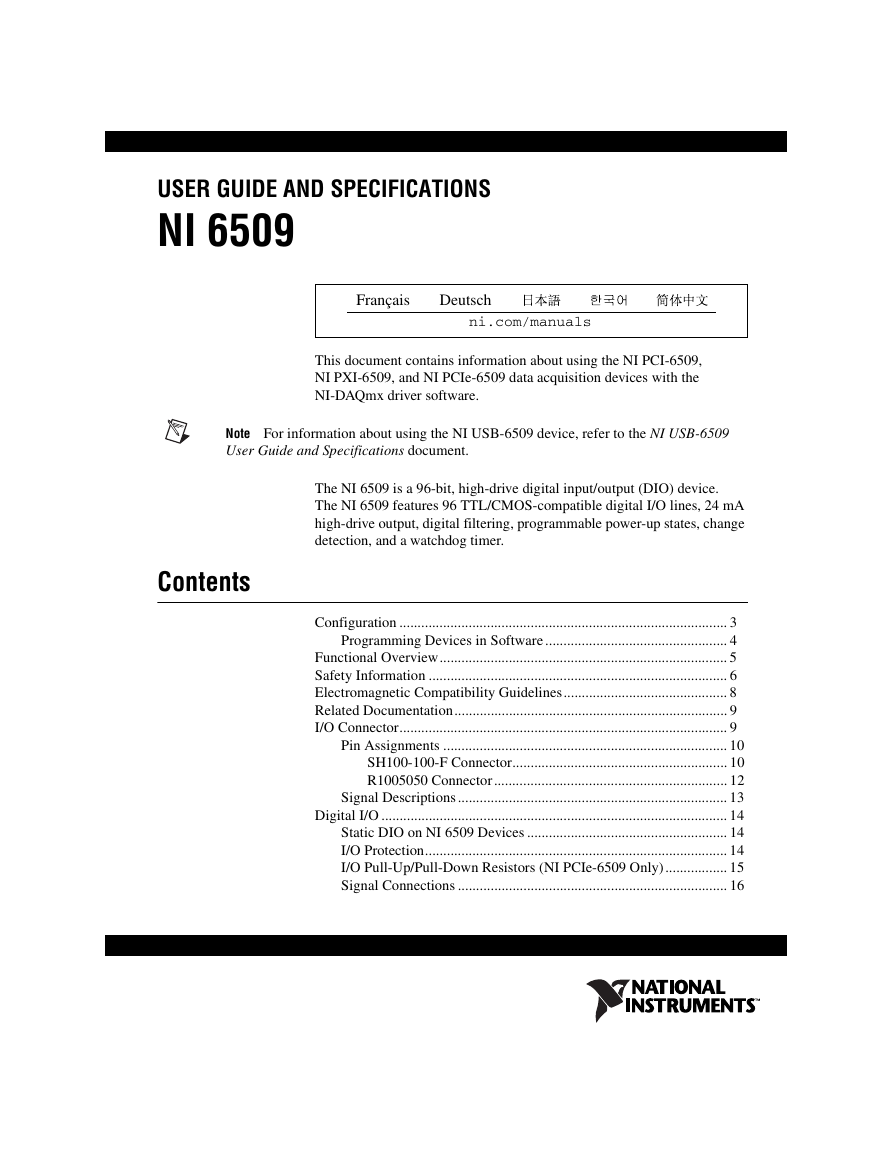
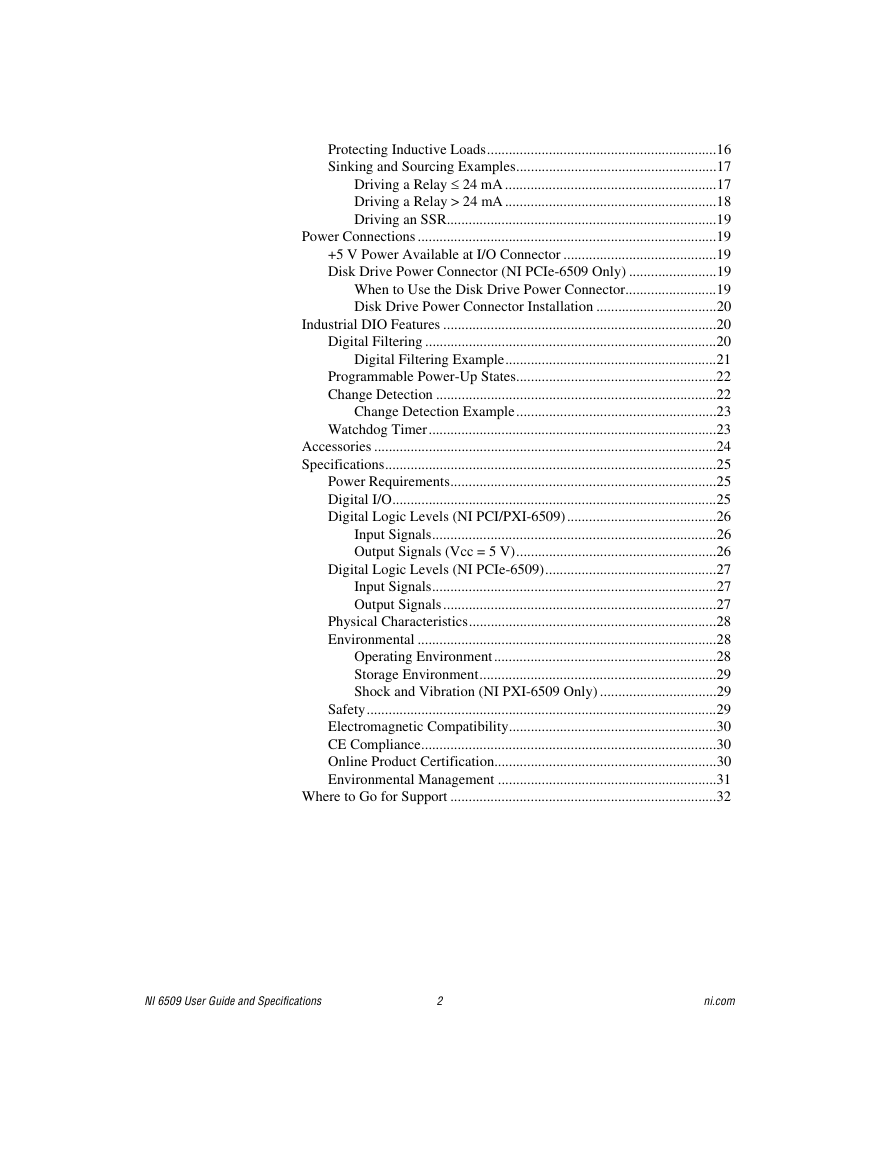
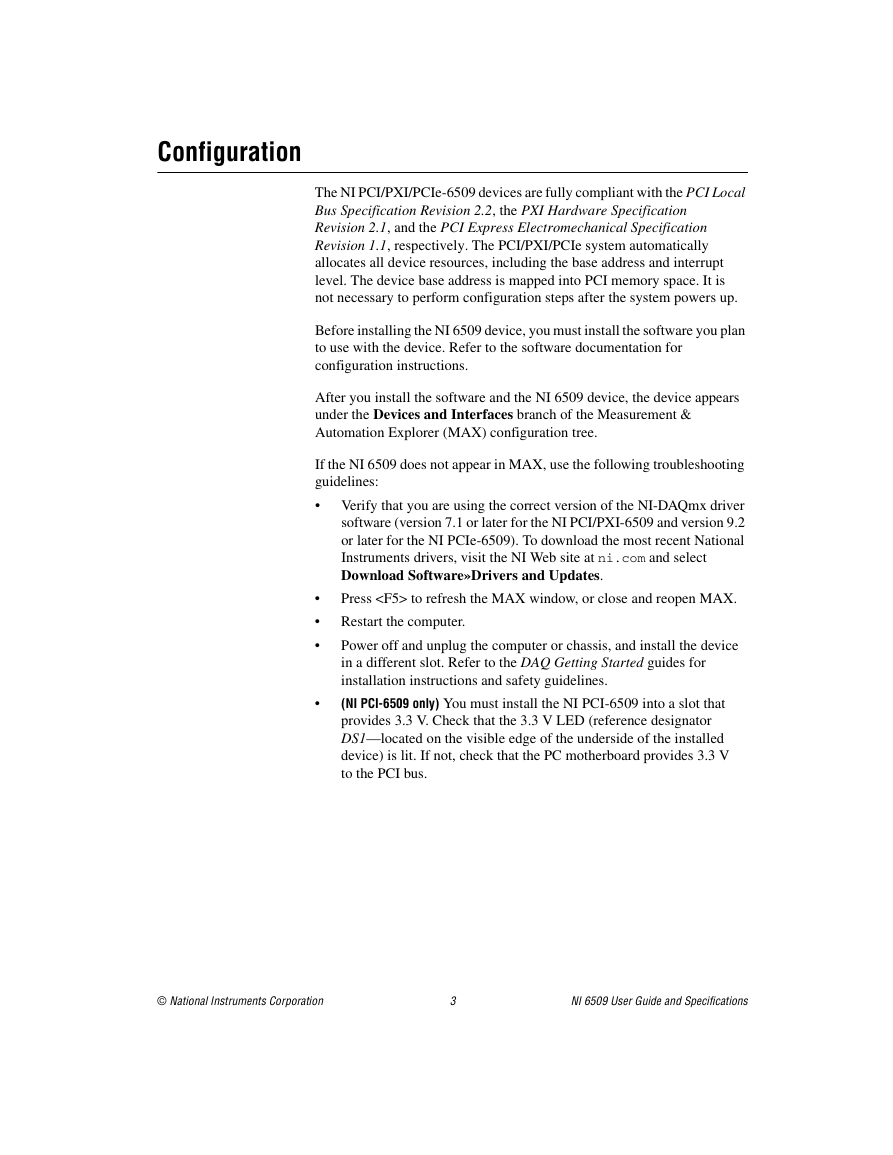
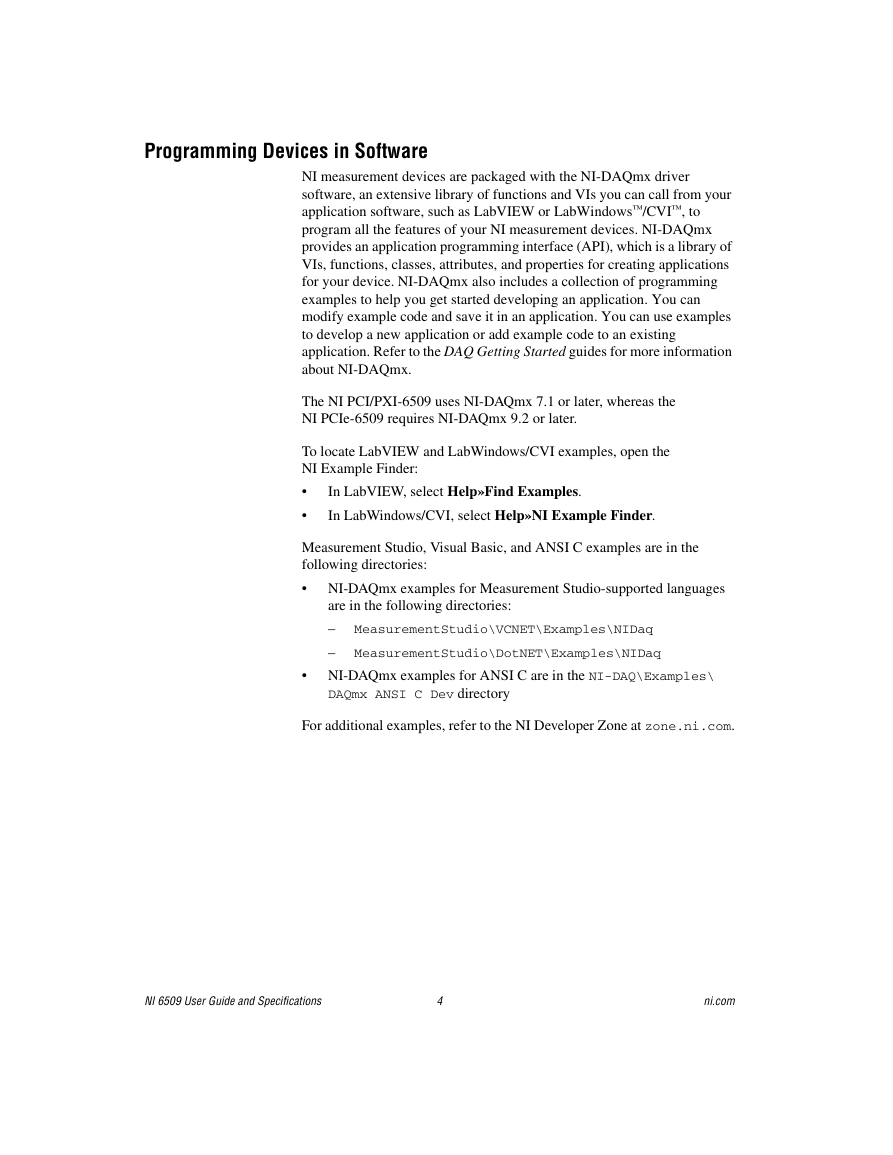
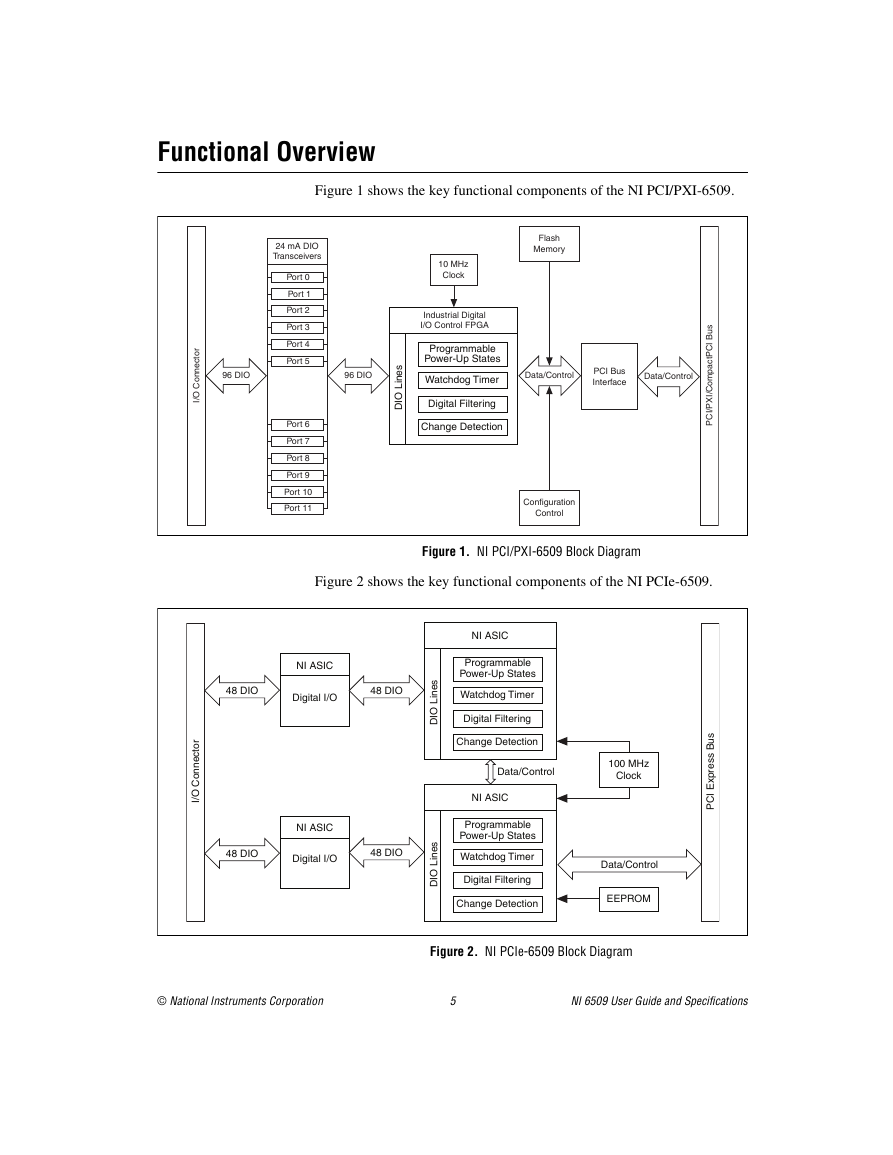











 2023年江西萍乡中考道德与法治真题及答案.doc
2023年江西萍乡中考道德与法治真题及答案.doc 2012年重庆南川中考生物真题及答案.doc
2012年重庆南川中考生物真题及答案.doc 2013年江西师范大学地理学综合及文艺理论基础考研真题.doc
2013年江西师范大学地理学综合及文艺理论基础考研真题.doc 2020年四川甘孜小升初语文真题及答案I卷.doc
2020年四川甘孜小升初语文真题及答案I卷.doc 2020年注册岩土工程师专业基础考试真题及答案.doc
2020年注册岩土工程师专业基础考试真题及答案.doc 2023-2024学年福建省厦门市九年级上学期数学月考试题及答案.doc
2023-2024学年福建省厦门市九年级上学期数学月考试题及答案.doc 2021-2022学年辽宁省沈阳市大东区九年级上学期语文期末试题及答案.doc
2021-2022学年辽宁省沈阳市大东区九年级上学期语文期末试题及答案.doc 2022-2023学年北京东城区初三第一学期物理期末试卷及答案.doc
2022-2023学年北京东城区初三第一学期物理期末试卷及答案.doc 2018上半年江西教师资格初中地理学科知识与教学能力真题及答案.doc
2018上半年江西教师资格初中地理学科知识与教学能力真题及答案.doc 2012年河北国家公务员申论考试真题及答案-省级.doc
2012年河北国家公务员申论考试真题及答案-省级.doc 2020-2021学年江苏省扬州市江都区邵樊片九年级上学期数学第一次质量检测试题及答案.doc
2020-2021学年江苏省扬州市江都区邵樊片九年级上学期数学第一次质量检测试题及答案.doc 2022下半年黑龙江教师资格证中学综合素质真题及答案.doc
2022下半年黑龙江教师资格证中学综合素质真题及答案.doc